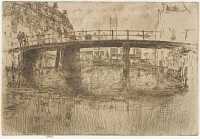Etchings Institutions search term: hughes kimber
Bridge, Amsterdam | ||
| Number: | 447 | |
| Date: | 1889 | |
| Medium: | etching and drypoint | |
| Size: | 165 x 241 mm | |
| Signed: | no | |
| Inscribed: | no | |
| Set/Publication: | no | |
| No. of States: | 5 | |
| Known impressions: | 13 | |
| Catalogues: | K.409; M.409; W.267 | |
| Impressions taken from this plate (13) | ||
TECHNIQUE
An extremely complex web of line, cross hatching and shading in both etching and drypoint, developed through five states. Whistler extended the detailed shapes and textures to the edge of the plate except at upper right.
PRINTING
The '1st proof pulled' was printed on buff 'antique' (pre-1800) laid paper, with soft tone, delicately wiped in curving horizontal strokes ( ). Early impressions were printed in brown ink on ivory laid paper with the watermark of a Hunting horn in a shield (
). Early impressions were printed in brown ink on ivory laid paper with the watermark of a Hunting horn in a shield ( ) as well as in black (
) as well as in black ( ) or dark brown ink (
) or dark brown ink ( ) on ivory laid paper; and the final state was printed in a very dark brown ink, on cream 'antique' textured laid paper (
) on ivory laid paper; and the final state was printed in a very dark brown ink, on cream 'antique' textured laid paper ( ) and ivory laid paper (
) and ivory laid paper ( ). All are trimmed to the platemark and signed on a tab with the butterfly and 'imp.' to show that Whistler printed them.
). All are trimmed to the platemark and signed on a tab with the butterfly and 'imp.' to show that Whistler printed them.
 ). Early impressions were printed in brown ink on ivory laid paper with the watermark of a Hunting horn in a shield (
). Early impressions were printed in brown ink on ivory laid paper with the watermark of a Hunting horn in a shield ( ) as well as in black (
) as well as in black ( ) or dark brown ink (
) or dark brown ink ( ) on ivory laid paper; and the final state was printed in a very dark brown ink, on cream 'antique' textured laid paper (
) on ivory laid paper; and the final state was printed in a very dark brown ink, on cream 'antique' textured laid paper ( ) and ivory laid paper (
) and ivory laid paper ( ). All are trimmed to the platemark and signed on a tab with the butterfly and 'imp.' to show that Whistler printed them.
). All are trimmed to the platemark and signed on a tab with the butterfly and 'imp.' to show that Whistler printed them.After Whistler's death three impressions were printed by Nathaniel Sparks (1880-1956) at the request of Rosalind Birnie Philip (1873-1958). On 18 June 1931 Sparks sketched the plate and later recorded in his distinctive and practically illegible writing:
'Plate in good condition
Amsterdam bridge - / Figures on bridge
6/5/32
(Three proofs) Etched Plate / with / Dry point: Burr removed.
(One on pailing paper -
Two on paper without a mark apparently).' - 10
Amsterdam bridge - / Figures on bridge
6/5/32
(Three proofs) Etched Plate / with / Dry point: Burr removed.
(One on pailing paper -
Two on paper without a mark apparently).' - 10
10: Martin Hopkinson, 'Nathaniel Sparks's Printing of Whistler's Etchings', Print Quarterly, 1999, Vol. 16, No. 4, pp. 340, 345, 352.
Sparks's notes, and spelling, are not entirely clear. However, 'pailing' (a fence) suggests this was the Pro Patria watermark, and of the two known Sparks impressions, one is printed in dark brown ink on ivory laid paper with an obvious Pro Patria watermark ( ). The other paper is similar but with no watermark (
). The other paper is similar but with no watermark ( ) and this impression is reproduced below. They were signed on the verso by Sparks, and were not trimmed to the platemark, so that they could not be confused with lifetime impressions.
) and this impression is reproduced below. They were signed on the verso by Sparks, and were not trimmed to the platemark, so that they could not be confused with lifetime impressions.
 ). The other paper is similar but with no watermark (
). The other paper is similar but with no watermark ( ) and this impression is reproduced below. They were signed on the verso by Sparks, and were not trimmed to the platemark, so that they could not be confused with lifetime impressions.
) and this impression is reproduced below. They were signed on the verso by Sparks, and were not trimmed to the platemark, so that they could not be confused with lifetime impressions.
